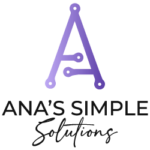Maximize Your Productivity with Airtable for ADHD
How does Airtable help individuals with ADHD stay organized and focused?
Airtable supports individuals with ADHD by offering a versatile platform that simplifies task and information management. Its user-friendly interface and customizable features like diverse view options, automation, and linked records cater to the unique organizational challenges faced by those with ADHD.
To say that ADHD has had a profound on my life is pretty much the understatement of the century. Of course, I didn’t realize how much of an understatement it was until I started to suspect and was finally diagnosed with neurodiversity last year.
I had lived for 46 years before that thinking that although my parents said I was smart, there were just some things I couldn’t wrap my head around, and although I was really good at problem-solving, understanding emotions, and music… there were just some HARD things. And I was frustrated.
The more I meet other women that have a similar story, I realized how our strengths can be so overshadowed by what’s HARD, that we constantly berate ourselves for not getting shit done.
It just so happens that my early problem-solving, combined with a Compaq computer, and lots of outdoor imagination time allowed me to mull on the ways I could make up for my “detriments”.
I became a big fan of spreadsheets, columns, and rows that helped me organize my information not only to organize my life but also to keep my notes for college classes and basically calm the overwhelming beast that would eventually take over my brain.
The world has come a long way since the first appearance of Excel, but I still feel that the structure a spreadsheet gives you can be extremely helpful in organizing information that our brains have a hard time putting together.
Airtable is a database tool that has become more and more popular in recent years for small and large businesses because of it’s flexibility and ease of use when it comes to the organization of information. It can be organized and viewed in a variety of ways, allowing the user to be able to use it in the way that works best for their brain.
I wanted to take some time to explain why the Airable features are so helpful to those who may be challenged with their executive functioning and make some recommendations for the use of this tool inside and outside of business.
What is ADHD?
ADHD, which stands for Attention Deficit Hyperactivity Disorder, is a neurological condition that can affect a person’s ability to focus, control impulses, and maintain consistent energy levels.
It’s like having a brain that’s a bit differently wired than the neuro-typical person. It makes some things like executive function, cognitive control, and impulsiveness harder to control. As mentioned before, I have had this my whole life but only recently found out what it was. My two children have also been diagnosed with ADHD, which affects executive function and other cognitive skills.
While it can be viewed as a disability, I am extremely passionate about using the positive aspects of it to help my clients gain success and allow systems and technology to help keep focus on the things that matter.

Nevertheless, there are some specific things that ND individuals can do to help themselves with the help of technology.
First, let’s talk about some of the main challenges that those who are “neuro-spicy” or neurodivergent may deal with.
- Easy distractions – ADHD individuals are easily distracted by multiple things in their environment. Eliminating distractions on the technology front can be extremely helpful.
- Trouble prioritizing. When everything feels important, nothing is important. Knowing how to identify the important tasks, data, and information quickly before their minds grab something can make the difference between focusing on a task or being distracted by something else. While we generally are better with routine tasks, sometimes things out of the ordinary may throw us off.
- Information Overload. One of the reasons why it can be difficult for those with ADHD is that we are easily overwhelmed by all of the information we can see on our screens. Being able to view everything at once may seem like a benefit, but in reality, making all those connections can just feel like a tidal wave washing over you.
- Keeping items in short-term memory. Because those with ADHD tend to have a harder time with focus on capturing and organizing information, it can be harder to keep things in short-term memory, even if they are right in front of our face. If we aren’t focusing on it, it will just pass us by.

Features in Airtable that are beneficial for those with ADHD.
The best part about Airtable for ADHD in my opinion is that it is based on simple principles, columns and rows, but the way you can create multiple categories, and view it in different ways is what makes it SO powerful especially for ADHD brains that need to process information differently and have more unique challenges that most neuro-typical individuals.
Let’s review some of the aspects of Airtable that can really be helpful in this regard.
- Custom Fields: Airtable supports various field types like text, number, date, checkbox, attachments, and more. You can create a multitude of categories and fields that give a different bit of context to the main piece of information. For example, you can use attachment fields to store images or documents directly in your base, or link records to create relational databases.

- Linked Fields: How many times have you found yourself putting in duplicate information in different programs or even within the same software? Things like Client information and emails, or even your product descriptions, etc. Being able to link fields together in Airtable allows you to create “Master files” of different parts of your life or business and align them wherever you need to by using Linked and Lookup fields.

- Views: Views allow you to see your data in different formats, including grid, calendar, kanban, gallery, and form views. This flexibility helps in managing tasks, timelines, and workflows more efficiently and for different types of looking at the data. For instance, a Kanban view can be used for agile project management, while a calendar view is perfect for scheduling or looking at a Content Calendar.

- Formulas: Airtable allows for the use of formulas similar to those in spreadsheets, enabling you to perform calculations or manipulate data within your base. While this may be a little bit of a more advanced use case, you’d be amazed how some of the most simple formulas can help you expand the Airtable for ADHD functionality.
- Integrations: Through its API and services like Zapier or Integromat, Airtable can integrate with a wide array of other apps and services, automating workflows between platforms. Some of my favorites are Slack, Google Drive, and ClickUp. This means you can connect Airtable with your email, calendar, marketing platforms, CRMs, and more, streamlining processes across your tools and not having to THINK about it all the time.

- Base Templates: Airtable offers a wide range of pre-built templates (as do I!) for different industries and use cases. These templates can save time and provide a structured start for your project, whether you’re managing a marketing campaign, tracking a product launch, or organizing a content calendar. I don’t even start from scratch with my bases, I either use a base I’ve created before (find my templates HERE) or I use one of the many free ones that Airtable offers.
- Syncing: You can sync data between different bases or even from external sources like Google Calendar or Dropbox. This ensures that your information is up-to-date across all platforms, reducing manual data entry and potential errors. It’s like using multiple tech systems as 1 all-in-one system specifically designed for YOUR business.
- Automation – If the base is built for your business, and you have all of your views and custom fields set up to help you organize, find and act on the information in there, the next step would be to DEFINITELY include automation. I’m not even talking about external automation using third-party tools like Make or Zapier, there is a plethora of internal automation that you can create just within Airtable that puts it miles above the majority of tools available for small businesses and is a great help to those that have a hard time imprinting information in their short term memory and suffer from neurodiversity.
I could go on, but I feel as though 8 is enough to tackle at this point 🙂.
So HOW are these Airtable features helpful for Neurodiversity?
Because every person’s brain works differently, tools that are made to be flexible are always the best bet when it comes to working with them. Sometimes it takes a bit to set it up, but once it’s there, it’s smooth sailing.
Always out software for yourself to make a decision, especially if you are overwhelmed and/or think differently than the average person, but if you are someone who is easily distracted, has trouble prioritizing, lack-of-clarity, suffers from information overload or have trouble keeping information in your short-term memory, you can understand how the features above, particularly the single trusted system, can help you get things done. This is especially beneficial for neurodiverse individuals who may struggle with sensory overload and context-switching.
Being able to have all the important information you need in one place (imagine all of your Zoom links and Calendar scheduling links in one place), reduces the need to hop between different tabs or browser instances. Much less of a chance of seeing an unfinished task and getting distracted from what you were doing. Additionally, Airtable’s email management feature allows for automatic sorting of incoming emails into specific folders, reducing clutter in your inbox and saving mental energy.

How about sending out an email to a lead if you haven’t contacted them in a week automatically?
Or syncing your Google calendar to your Airtable base so you can see when you have availability for consulting sessions without ever having to leave the program?
Finally, you can view the images for all of your social media posts in one place thanks to attachments AND can automatically post them on the prescheduled post-date. Amazing for your brain and saving a lot of time? Yes, please!
Interested in figuring out how to do this? Schedule a FREE Strategy call with me!
How you can get started on Airtable as a neurodivergent business owner
I want to point you to all of these awesome functionalities because I truly believe that Airtable is one of the best programs out there to do EVERYTHING that needs to be done to organize and streamline a business. However, much like any tool, starting out on it can feel a bit daunting. Especially for an ADHD entrepreneur or business owner who gets distracted by all the shiny objects.

Steps to get started in Airtable
- Figure out the information in your business that you would REALLY benefit from it was organized. Client data? Product information? A centralized place for all of the disparate links and important things you need to see?
- Once you know what that is, check out my templates (here) or Airtable free templates to see if there is one that reflects your needs.
- Set up your first table with the MAIN information needed for the information.
Examples: Client First Name, Last Name, Email, Socials - Set up additional Tables for “related” information.
Examples: Products Clients have purchased, Financials of when clients have last paid and what they paid, any forms that you would like them to fill out. - Customize fields (Short text, long text, drop-downs, multi-list) as needed to best classify and
- Add all of your data and information
- Link the fields and tables that require it for a fuller understanding
- Experiment with the views to find one that works best for you and/or your team.
- Share and collaborate with other team members or embed the view into another tool.
- Iterate and Improve over time.
Want a video or youtube of these steps? Let me know! (Email me here! [email protected])
In conclusion, Airtable for ADHD 😙
So regardless of your “condition” or your struggles in everyday life with executive functioning or just being overwhelmed by all of your ideas and thoughts, make sure you take the time to recognize your unique strengths.
We are super lucky to have tools like Airtable to be able to manage some of the areas where we feel like we lack (or rather there is so much going on in our heads that we NEED something out there to put in all our brain thoughts.
The flexibility and adaptability of such platforms are especially beneficial, allowing you, and everyone to leverage their strengths and address their challenges effectively. Airtable’s features, from customizable fields to automation, provide a structured yet adaptable environment that can be tailored to various cognitive and organizational needs.
I challenge you to try it out, see how it can help you and organize all the things.
The only way to learn something is to USE it!
Grab my FREE Productivity Workbook below
Looking to learn more?
Check out these blogs:
The ultimate ADHD productivity system 👈
Ditch the multi-tasking myth 👈
Mastering Client Communication 👈




